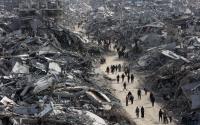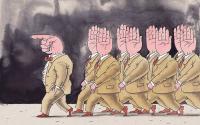Rich City Poor City: Middle-class Neighborhoods Are Disappearing from the Nation's Cities, Leaving Only High- and Low-Income Districts, New Study Says
Common Dreams / Published on Thursday, June 22, 2006 by the San Francisco Chronicle
Ron Miguel, a retired florist and native San Franciscan, can remember when a middle-class family could buy a home in the city without breaking the bank. But over the decades, he has watched that change.
"When we moved into Potrero Hill 30 years ago, this was an affordable area ... but today I couldn't afford the homes and condos going up a block from me," said Miguel, 75. "You have a situation where the cost of housing is astronomical. It's very difficult for the middle income to survive."
The gentrification of San Francisco's neighborhoods reflects one facet of a national trend: the decline of middle-income neighborhoods in metropolitan America, according to a report released today by the Brookings Institution, a nonprofit think tank in Washington, D.C.
In other American cities like Baltimore and Philadelphia, what were once middle-class neighborhoods gave way to poverty as middle-income residents departed for the suburbs and beyond, said Alan Berube, a Brookings fellow who oversaw the study. But in San Francisco and across the Bay Area, middle-class neighborhoods are disappearing as the skyrocketing cost of housing forces middle-income families to flee in search of affordability.
"If the only place you're building middle-income housing is in the Central Valley, that's where middle-income growth will go," Berube said.
The study looked at the income levels for families and neighborhoods in the nation's 100 largest metropolitan areas from 1970 to 2000 and found that the decline in the number of middle-income neighborhoods outpaced the fall-off in middle-income families. That's partly a consequence, Berube said, of people "sorting themselves" into richer and poorer neighborhoods with less economic mixing.
"You've got families moving up the economic ladder who want to buy a better house in a better neighborhood, but that middle rung of the ladder isn't there," he said.
The end result could be "families living in the Bayview want to move up, and all that's left is Pacific Heights," Berube said. "Having those neighborhoods in the middle is important for economic and social mobility."
The study defined "middle income" as anywhere from 80 to 120 percent of the median family income for the region, which in the San Francisco metropolitan area was $75,200 in 2000.
Noe Valley is another neighborhood that has changed over the decades. In 1970, the median income in the area was roughly $10,000, just below the citywide median family income of $10,500. In 2000, the median income in the neighborhood had rocketed up to $110,000.
Art Vasquez, 57, grew up there on Valley Street. He and his sister inherited the family home, built by his father and uncle in the 1930s, and his son lives there now.
"The only way a blue-collar family can live here now is if they inherit a house or they live here all their life and stay here," said Vasquez, who works for Pacific Gas and Electric Co. "Back then it was reasonable. This was a place that Muni drivers or cops could afford."
How about now?
"No way," Vasquez said. "There's no way."
Jeannene Przyblyski, a professor at the San Francisco Art Institute and a two-decade resident of Noe Valley, said she has seen five houses near her Collingwood Street home torn down over the past 10 years to make way for larger, more luxurious dwellings.
"As real estate values escalated dramatically, people didn't see them as houses, they saw them as lots and they said, 'I can build the house I want with four bedrooms and three baths and the exhibition kitchen,' " she said.
But even in San Francisco, some neighborhoods have seen a decline. Once considered a middle-class neighborhood, the Western Addition, where the median income was 62 percent of the citywide figure in 2000, is now a low-income area.
The fact that middle-class families are priced out of the Bay Area's cities and suburbs creates an unhealthy economic segregation, said Sarah Karlinsky, policy director at the San Francisco Planning and Urban Research Association, known as SPUR, which advocates for urban economic vitality as a counterweight to suburban sprawl.
"It's bad for democracy," Karlinsky said. "When you have concentrations of poverty, people growing up there have less access to other life opportunities. The same is true at the other end, as well. ... We don't want San Francisco to become Carmel, just a city of the most wealthy. Then we're not a real city any more, we're a boutique."
And the problem isn't exclusive to San Francisco, she emphasized; the region's suburbs also need to increase the supply and variety of housing.
"When you've got a locality that's zoning for single-family detached housing, you're pricing a lot of people out," Karlinsky said. "When they shut the door to housing, people leapfrog further out."
When middle-income people -- be they firefighters, teachers, nurses or corporate office workers -- move to Tracy or Stockton, the housing may be cheaper, but those families and society as a whole pay new kinds of costs, said Brad Paul, a former San Francisco deputy mayor for housing and neighborhoods.
"If you're commuting two hours each way to work, it means you can't spend time with your kids," Paul said. "And there are transportation impacts in the amount of gas we burn, in global warming. Don't you want people to live and work in the same area?"
When middle-class families move to those subdivisions, they also lose out on the kind of cultural and economic diversity that cities can offer, said Jim Chappell, president of SPUR and a Noe Valley resident for 30 years.
"An old central city that grew up over 100 or 200 years has all kinds of neighborhoods in it, so there's a mixing of income groups," he said. "That's why so many of us love the city and wouldn't want to live anywhere else. We want to raise our kids where there are all kinds of people."
The report can be viewed at www.brookings.edu.
Chronicle staff writer Cicero Estrella contributed to this report.






